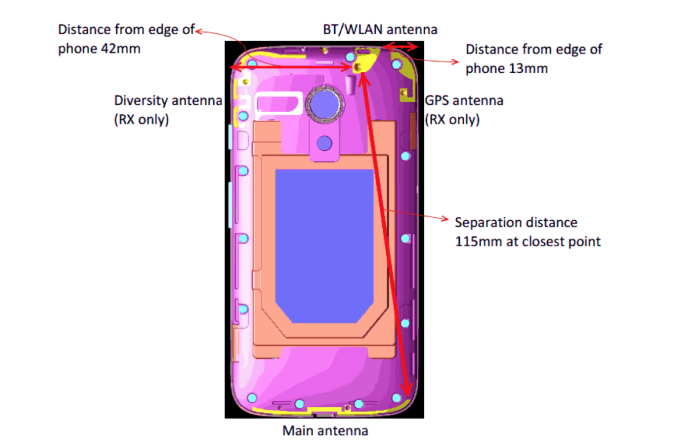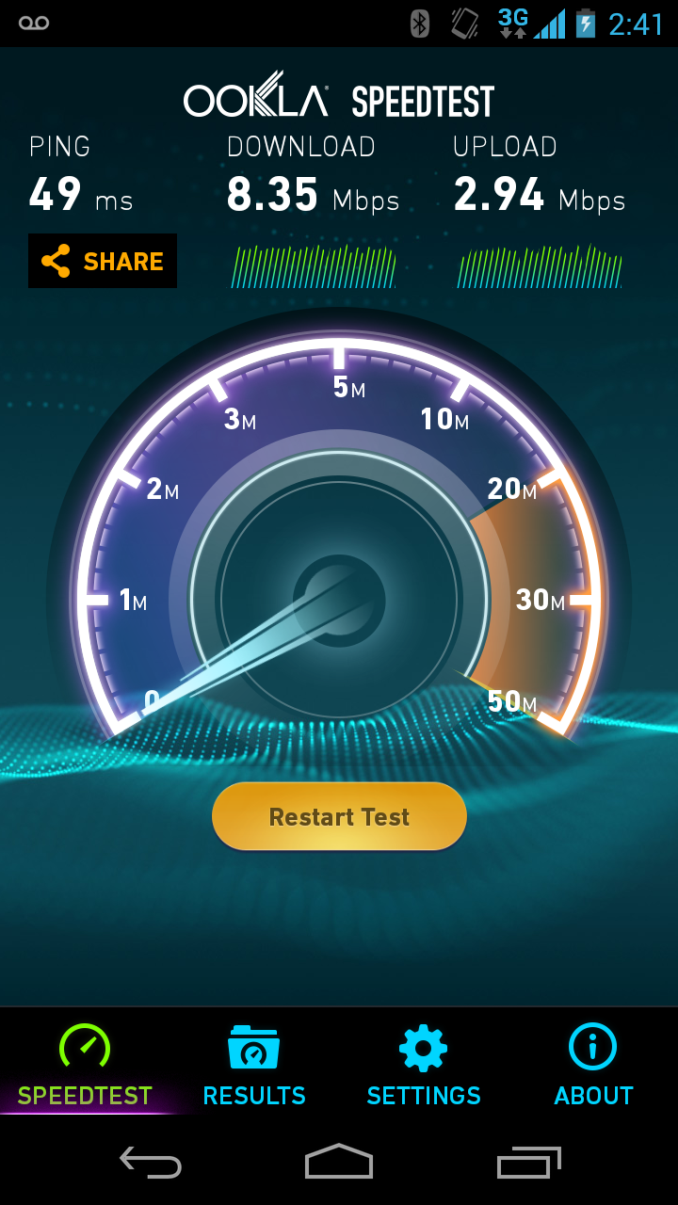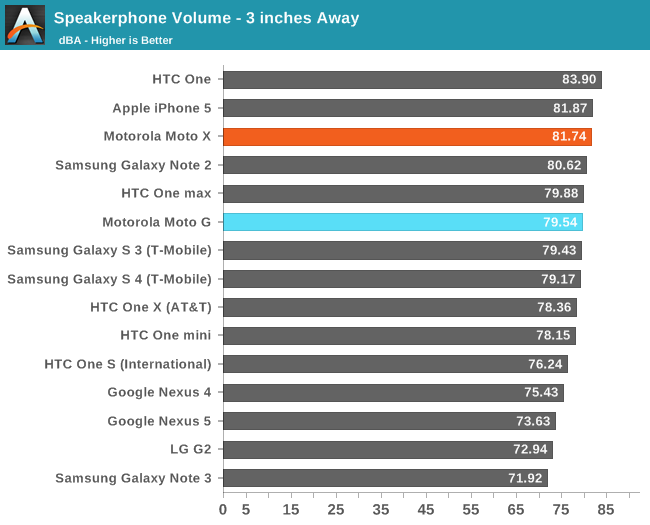Motorola Moto G Review
by Brian Klug on December 18, 2013 2:00 PM EST- Posted in
- Smartphones
- Motorola
- Mobile
- *VA
- Cortex A7
- snapdragon 400
- Moto G
Cellular
The cellular side of the Moto G is an interesting one, at least for those who have kept constantly abreast of wireless banding configurations and the state of mobile RF. At the high end, pentaband WCDMA is now essentially ubiquitous, with parity LTE banding (given the shared nature of ports on the transceiver) and at least a handful more bands for whatever’s appropriate to the region. There’s no global LTE band combination equivalent to quad band GSM or pentaband WCDMA that has emerged quite yet, but it’s getting there, and in the next generation or two we’ll undoubtedly finally see it come to fruition.
|
Moto G (US GSM) |
Moto G (Global GSM) |
Moto G (CDMA) |
|
| Baseband | MSM8x26 - (Up to HSDPA 21.1 Enabled, EVDO Rev.A for CDMA) | ||
| Transceiver | WTR2605/WFR2600 (?) | ||
| GSM | 850/900/1800/1900 MHz | - | |
| CDMA2000 | BC: 0/1/10 | - | 850, 1900 MHz |
| WCDMA |
850, 1700/2100 (AWS), 1900 MHz (Bands 2, 4, 5) |
850, 900, 1900, 2100 MHz (Bands 1,2,5,8) |
- |
| LTE | - | - | - |
The Moto G however comes in a number of different flavors with different band combinations – there’s US GSM, Global GSM, and CDMA. I also suspect there’s at least one more dual SIM variant that we haven’t seen crop up just yet (Update: Apparently this exists already, XT1033 is the dual SIM variant, thanks @evefavretto). On the back case of Moto G there’s a space whose shape matches the microSIM tray at top, and on the board there’s a shield covering pads that are undoubtedly for a microSIM. Interestingly enough Motorola sampled me the Global GSM variant of the Moto G which lacks Band 4. I’ve been using it on T-Mobile successfully however thanks to the relative ubiquity of the 1900 MHz WCDMA carrier in my market. The US GSM variant of the Moto G trades Band 4 for 1 and 8 (2100 and 900 MHz), two popular bands internationally. I’ve seen Moto G erroneously listed as being a pentaband WCDMA phone, which it unfortunately isn’t.

Primary Rx/Tx at bottom, Diversity Rx up top, WLAN/BT, GNSS Rx
Moto G does offer a leg up with receive diversity for CDMA1x/EVDO and HSPA+, something that some HSPA+ flagships from this generation amazingly enough still don’t include. The transceiver is WTR2605 for the primary Rx and Tx ports, and WFR2600 for the additional Rx diversity path. I have no idea what the port configurations look like for WTR2605, but I’d imagine it looks like a cut down WTR1605 of some kind. I have a suspicion that WTR2605 was designed for a quad band UMTS configuration with Bands 1,2,5, and 8, so it might indeed already be port limited in the Global GSM Moto G variant. I also wouldn’t be surprised if there’s some ready made front end module at the front of the whole thing.
Moto G arrives without LTE and instead offers up to single carrier HSPA+ with 64QAM, for up to 21 Mbps on the downlink. Although MSM8x26 itself has a modem block capable of up to dual carrier HSPA+ and category 4 LTE, it seems as though Motorola went for single carrier HSPA+ in the Moto G for time to market reasons, with the LTE and dual-carrier HSPA+ enabled software tree likely slotting in a quarter later than the initial code drop with single carrier HSPA+.


Not bad for single carrier HSPA+ on T-Mobile USA
I’ve been pretty pleased with the cellular performance of the Moto G, even using the variant that lacks Band 4 on T-Mobile USA. Not having LTE made me initially skeptical of it getting operator traction in the US, but it seems as though Motorola has actually had success at least on some prepaid tiers. I’ve been spoiled with LTE devices for a long time now, but single carrier HSPA+ is absolutely still survivable.
WLAN
WiFi connectivity on Moto G is single band 2.4 GHz 802.11n with BT 4.0 and FM receive. On the Moto G, that connectivity is courtesy the new WCN3620 BT/FM/WLAN RF combo chip in a wafer scale package. We’ve now seen WCN3660, the initial dual band combo, then WCN3680 which added 802.11ac, and now WCN3620, the cost reduced version which is single band 802.11n and no doubt offered at a competitive price point with the rest of the platform.
The WLAN/BT stack doesn’t do any antenna sharing and instead has its own transmit and receive path on the top of the Moto G. I don’t have any complaints about WLAN range on the Moto G.
To evaluate performance we turn to the same iPerf test same as always. I was able to attach the Moto G to my network at the 65 Mbps PHY rate that corresponds to long guard interval with a 20 MHz channel.

Performance is pretty decent at just over 50 Mbps. It’s a significant delta over the latest devices with dual band 80 MHz 802.11ac support, but again, totally solid relative to the tier it’s in.
Speakerphone and Noise Canceling
Speakerphone on the Moto G seems to be a big chamber if you take the back off, but there’s a relatively small seal against the whole affair, although the grille has larger holes than Moto X’s relatively tiny ones. Loudness is competitive, but unsurprisingly short of Moto X.

I’d describe Moto G’s speaker as decent, not overly loud or rich sounding.
Dual microphone noise suppression is still a somewhat notable feature at the midrange. In the case of Moto G, Qualcomm’s Fluence package is used in a configuration with the primary microphone at bottom and secondary at very top. I did some digging and also found that Moto G is using Qualcomm’s WCD9302 audio codec which we haven’t seen before, again a more midrange variant. I’ll leave the earphone/line out audio testing for Chris to evaluate.
Noise suppression on the Moto G is decent, but seems to have longer adaptation time than the Moto X. Using the exact same setup, I definitely noticed better rejection on Moto X as well, with less noise being passed through at the same volume level. I should also note that the Moto G does not appear to be AMR-WB enabled on T-Mobile.
GNSS
GNSS onboard the Moto G is the same Gen 8B as we’ve seen on 8974, which translates to support for GPS (USA “Navstar”), GLONASS (Russia), and Beidou (China), although the spec table for Moto G only lists GPS and GLONASS, leading me to believe Beidou might be reserved for devices destined for China. There’s a discrete antenna for GNSS on the Moto G, and I had no issues with getting fast, accurate 3D fixes. I remain impressed with Qualcomm’s GNSS which obviously benefits from integration right into the SoC.










120 Comments
View All Comments
uhuznaa - Wednesday, December 18, 2013 - link
Even my 8 GB Nexus 7 has a two GB left. Lots of storage is convenient for the lazy and the horders, but in now way something that makes or breaks a device for "normal" use. "3-4 GB of music" is about 1000 songs. Yeah, more is better, always, but don't make this into more of a limitation than it actually is. Most people don't care very much anyway.apertotes - Wednesday, December 18, 2013 - link
a tablet is not at all like a phone. a tablet sits at home mostly, with WiFi and instant access to hundreds of online services. A phone goes with you everywhere, even places without -gasp- internet. And most people care, indeed, and that is why they buy galaxies instead of ones.Bob Todd - Wednesday, December 18, 2013 - link
Do you have any proof that the majority of Galaxy S* buyers do so because of micro-SD or removable batteries? Survey data from a reasonable cross section of buyers? I like both of those features, but the idea that it is the main driver of Samsung's success with that line doesn't seem to be grounded with any facts. I'd assume marketing plays the biggest role, along with actually building a solid brand behind it (one high end line available on most major carriers updated once per year). Yes some % of users care a great deal about removable storage and removable batteries, but if you think that's the secret to their success I think you are deluding yourself. And I'm almost sorry I responded at all to the inevitable whining about removable storage. There are other cheap devices that offer those features, be happy that a quality option is available at this price point.apertotes - Wednesday, December 18, 2013 - link
Well, HTC thought the same last year, after their beautiful HTC ONE X beat the Galaxy S3 in every review, but lost badly on sales. "It's the marketing!". They lost another good year blaming marketing, and now are even in worse situation than a year ago. Or do you want to convince me that HTC is not a strong brand? Or Blackberry, for what it is worth.Yes, Samsung sells lots of Aces very cheap, but S3 and S4 and Notes are not cheap. And they outsell almost the rest of high end android devices combined. I really do not think that Samsung is that good at marketing.
Impulses - Wednesday, December 18, 2013 - link
Nope, HTC isn't a very strong brand outside of tech enthusiasts. Samsung/Galaxy is a lot more easily recognized... I had three HTC phones in a row (all the EVOs), very early random people would ask me if they were "the new iPhone" (never mind the massive size difference). Later on most friends would ask "did you get a Galaxy?" when they'd see I have a new phone, never mind it says HTC front and center...Samsung is ABSOLUTELY that good at marketing, have you watched network TV or looked at print magazines lately? Geeks may not do that much anymore but the general public does and Samsung's ad campaign is all over that media, it's impossible to ignore.
sajara - Saturday, December 21, 2013 - link
Indeed you're absolutely right. Samsung is a very powerful brand just about everywhere due to marketing. That, produces free publicity through brand awareness and then word of mouth. Even in the Dominican Republic a (developing country) where i go regularly, a sacred Blackberry land, is buying in bulk Galaxy(s) and why? Huge billboards everywhere and all 4 carriers selling just about every model.sajara - Saturday, December 21, 2013 - link
I was referring to Impulse's post btw...Bob Todd - Wednesday, December 18, 2013 - link
Again, what proof do you have to the contrary? Like I said, I'm sure some % of their user population does buy the Galaxy line _specifically_ for micro-SD and a removable battery. But I'd put a decent chunk of change on the size of that % being 1 in every 5 buyers or less. You think all those buyers of a mainstream device (who have no idea what SOC is in their phone or even what a SOC is) are walking into their carrier's stores with a 64GB micro-SDXC card full of stuff? There is a lot more to the success of the Galaxy line than removable batteries and expandable storage.apertotes - Wednesday, December 18, 2013 - link
I do not need to give any proof at all. I am not in the industry, and I could not care less. But it is funny watching people that should really know about this stuff (like HTC spokesperson) blame it all on marketing time after time, and get worse results every year.Also, HTC is a very strong band. A few years ago it was almost a synonym of smartphone, and they also spend a lot of money on advertising and sponsorships.
Anyway, do you have any proof that micro-sd cards are not a strong reason behind massive galaxy sales?
martajd - Wednesday, December 18, 2013 - link
"I don't need to give any proof." Yeah, you do